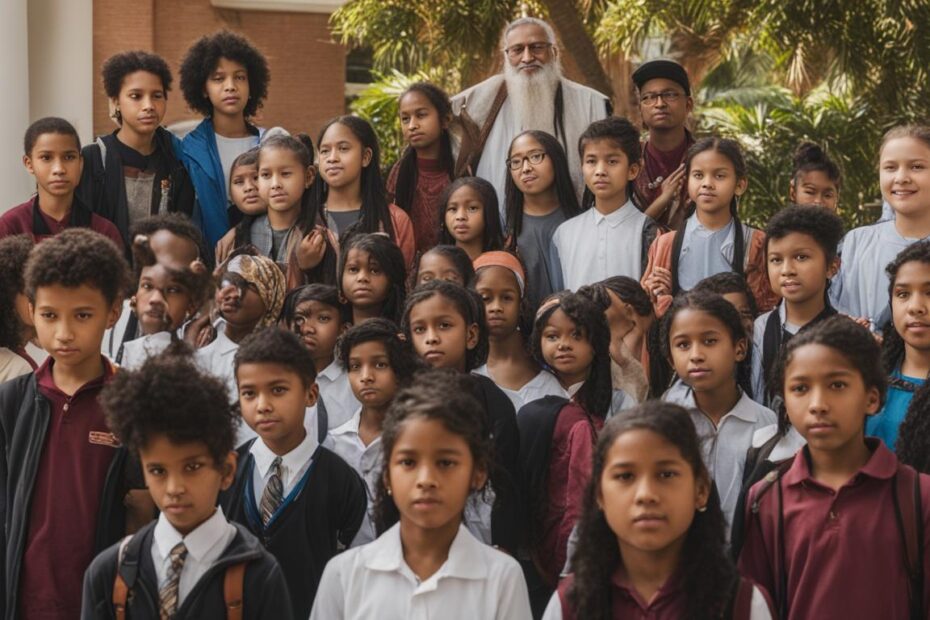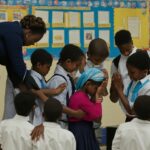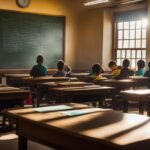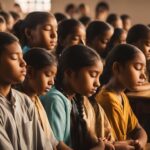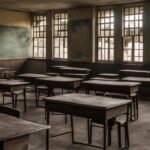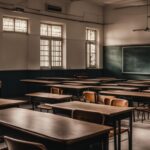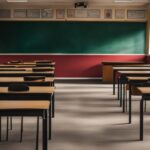The history of prayer in public schools in the United States is a complex and contentious topic. It has been 50 years since the Supreme Court banned school-sponsored prayer, but the presence of God and faith in public schools has continued to evolve. Student ministries, like the Fellowship of Christian Athletes and Campus Crusade for Christ, have expanded and reached thousands of students. Organizations like the Good News Clubs and “See You at the Pole” have also gained popularity. Additionally, interfaith groups and informal Bible study groups have emerged. Schools have also included religious instruction and discussions in their curriculum to address religious illiteracy. While many welcome the growing presence of religion in schools as a means of promoting understanding and inclusion, it is essential that it complies with the First Amendment and respects the separation of church and state.
Key Takeaways:
- The history of prayer in public schools has undergone significant changes in the past 50 years.
- Student ministries and religious organizations have continued to thrive in public school settings.
- Schools are addressing religious illiteracy through curriculum inclusion.
- The presence of religion in schools must comply with the First Amendment and respect separation of church and state.
The Supreme Court Rulings on Prayer in School
The issue of prayer in public schools has been heavily shaped by landmark Supreme Court decisions. Two notable cases, Engel v. Vitale (1962) and Abington School District v. Schempp (1963), declared school-sponsored prayer and Bible readings unconstitutional. These rulings sparked controversy and led to the removal of religious activities from school curricula. However, it’s important to note that the Supreme Court has also affirmed students’ rights to express their religious beliefs outside of school-sponsored activities.
The aftermath of these court cases has resulted in a layered legal landscape surrounding prayer in schools. Subsequent Supreme Court decisions have addressed various aspects of the issue, such as allowing student-led religious clubs and clarifying the boundaries of religious instruction during class hours. While school-sponsored prayer continues to be prohibited, the Court’s rulings have provided guidance on how schools can accommodate students’ religious freedoms within the framework of the First Amendment.
These Supreme Court decisions have shaped the legal boundaries for prayer in schools, ensuring that the establishment clause of the First Amendment is upheld. Schools must refrain from promoting or favoring any particular religion to maintain the separation of church and state.
The Supreme Court rulings on prayer in school have played a crucial role in defining the constitutional boundaries and ensuring the protection of students’ religious freedoms. These legal decisions have had a profound impact on the way prayer is approached in public schools, balancing the principles of religious expression and government neutrality.
The Debate on Prayer in Public Schools
The debate on prayer in public schools has been a topic of heated controversy for many years. Proponents argue that prayer in schools promotes religious freedom, moral values, and a sense of community. They believe that allowing students to express their faith openly fosters a positive learning environment. On the other side of the debate, opponents argue that prayer in schools violates the separation of church and state, infringes upon the rights of non-religious students, and creates a potentially exclusionary environment.
Those in favor of prayer in schools emphasize the importance of religious expression and the role of faith in building a strong moral foundation. They believe that prayer can provide comfort, guidance, and a sense of purpose for students, helping them navigate the challenges they may face in school and in life. They argue that allowing prayer in schools does not impose a specific religion on anyone but rather respects the individual’s right to express their beliefs.
However, opponents assert that public schools should be neutral spaces that do not favor any particular religion. They argue that prayer in schools can lead to discrimination and exclusion, particularly for students who do not adhere to the dominant religious beliefs. They emphasize the importance of maintaining a diverse and inclusive educational environment that respects the beliefs and values of all students.
Pros and Cons of Prayer in Schools
To further understand the debate surrounding prayer in public schools, let’s take a closer look at some of the pros and cons:
| Pros | Cons |
|---|---|
| 1. Encourages moral and ethical development | 1. Violates the separation of church and state |
| 2. Provides comfort and support for students | 2. Can create divisions and exclusions |
| 3. Fosters a sense of community and belonging | 3. Infringes upon the rights of non-religious students |
| 4. Respects the freedom of religious expression | 4. Can lead to proselytizing and coercion |
It is essential to recognize that the debate on prayer in public schools is multifaceted, involving constitutional considerations, educational values, and personal beliefs. As society continues to evolve, finding a balance that respects the rights and beliefs of all individuals while creating an inclusive educational environment remains a crucial challenge.
The Constitutional History of Prayer in School
The constitutional history of prayer in school is deeply intertwined with the First Amendment of the United States Constitution, which prohibits the government from establishing or promoting any particular religion. This principle of the separation of church and state has been a cornerstone of the legal interpretation of prayer in public schools.
Two landmark Supreme Court cases, Engel v. Vitale in 1962 and Abington School District v. Schempp in 1963, played a significant role in shaping the constitutional history of prayer in school. These cases established that school-sponsored prayer and Bible readings are unconstitutional. Schools are required to remain neutral and refrain from endorsing or favoring any specific religious practices.
In addition to these key rulings, subsequent Supreme Court cases have further clarified the boundaries between religious expression and government endorsement of religion in schools. The courts have upheld students’ rights to engage in voluntary, student-led prayer and participate in religious clubs and activities outside of school-sponsored events. However, schools must not promote or facilitate these activities or show any preference for a particular religious group.
| Supreme Court Cases | Year |
|---|---|
| Engel v. Vitale | 1962 |
| Abington School District v. Schempp | 1963 |
The First Amendment of the United States Constitution: “Congress shall make no law respecting an establishment of religion, or prohibiting the free exercise thereof.”
Historical Context
To understand the constitutional history of prayer in school, it is essential to consider the historical context in which these decisions were made. The United States is a diverse nation with citizens from various religious and non-religious backgrounds. It is crucial to maintain a balance that respects the rights of individuals to practice their own beliefs while ensuring a welcoming and inclusive environment for all students.
By upholding the separation of church and state, the courts have provided guidance on how schools can navigate the complex issue of religion in an educational setting. While students have the right to express and practice their faith, the schools themselves must remain neutral and avoid any appearance of endorsing or promoting specific religious beliefs.
As the cultural and religious landscape continues to evolve, the constitutional history of prayer in school will undoubtedly be shaped by new challenges and legal interpretations. It is crucial to find a balance that respects both the rights of individuals to practice their religion and the principles of neutrality and inclusivity that underpin the separation of church and state.
The Cultural Impact of Prayer in School
The history of prayer in public schools in the United States is a fascinating journey that has had a profound cultural impact. The removal of school-sponsored prayer and Bible readings sparked a transformation in the understanding of religious beliefs and practices within schools. As a result, student-led religious clubs and programs have flourished, promoting interfaith dialogue and education about various religions. This shift has not only influenced the school environment but has also shaped broader societal discussions on religion, tolerance, and the role of faith in public life.
One significant cultural impact of the changes in prayer practices is the greater awareness and acceptance of religious diversity within schools. Students now have more opportunities to engage with different faith traditions, learn about their beliefs, and foster a spirit of inclusivity. The growth of student-led religious clubs and organizations has created spaces where students can explore and express their religious identities, fostering a sense of belonging and community.
“The removal of school-sponsored prayer has opened up opportunities for students to engage with various religious traditions, promoting understanding and acceptance.”
Furthermore, the cultural impact of prayer in school extends beyond the educational setting. The broader discussions and debates surrounding prayer in public schools have illuminated the complex relationship between religion and society. These discussions have prompted individuals and communities to reflect on their own beliefs, values, and attitudes towards religious freedom. Ultimately, the cultural impact of prayer in school has played a significant role in shaping the landscape of religious expression and understanding in the United States.
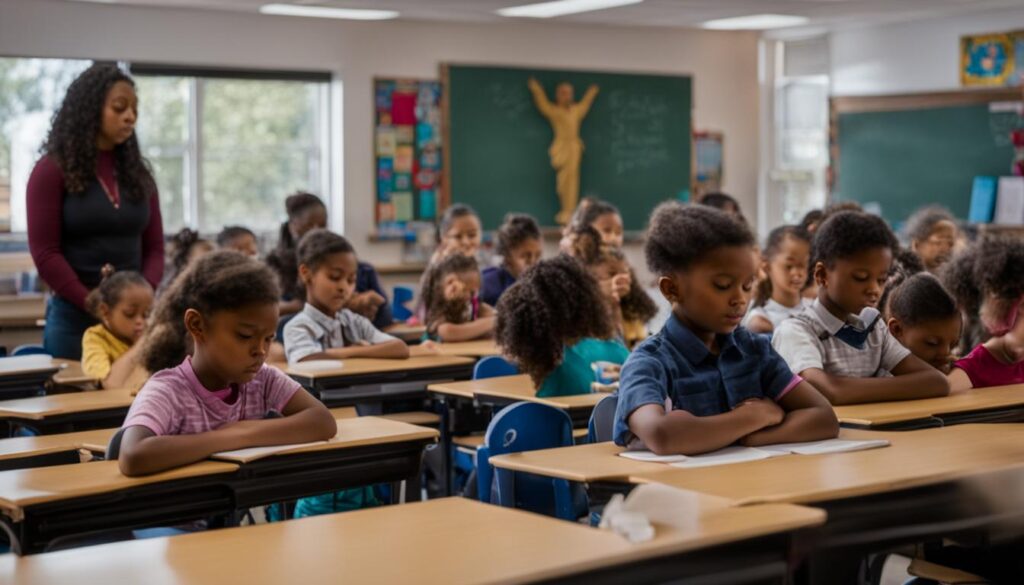
In conclusion, the cultural impact of prayer in public schools cannot be underestimated. The removal of school-sponsored prayer has given rise to a more diverse and inclusive understanding of religion within schools, fostering interfaith dialogue and education. It has also sparked broader discussions about religious freedom and the role of faith in public life. As society continues to evolve, it is essential to navigate the complexities of prayer in schools while promoting a welcoming and inclusive environment for all students.
Current Trends and Practices Regarding Prayer in School
The debate on prayer in public schools continues to shape the current trends and practices surrounding the issue. While school-sponsored prayer remains prohibited by the courts, there are instances where schools navigate the boundaries and allow certain religious activities. These practices vary across different school districts and communities, reflecting regional attitudes and legal interpretations.
One prevalent trend is the presence of student-led prayer groups. These groups provide a platform for students to express their religious beliefs and engage in prayer outside of school-sponsored activities. The Fellowship of Christian Athletes and Campus Crusade for Christ are prominent examples of organizations that have expanded their reach to thousands of students, fostering a sense of community and spiritual growth.
Informal Bible study groups also play a role in the current landscape of prayer in schools. Students with shared religious beliefs gather to study Scripture and engage in discussions about their faith. These groups often operate outside of official school hours and offer an opportunity for students to explore their beliefs in a supportive environment.
In Summary
Despite the restrictions on school-sponsored prayer, prayer in public schools has evolved through various trends and practices. Student-led prayer groups and informal Bible study groups provide avenues for religious expression and spiritual growth. However, the implementation and enforcement of these practices differ across school districts and communities. As the debate on prayer in schools continues, it remains important to strike a balance that respects both individual rights and the principles of religious freedom.
Conclusion
The history of prayer in public schools in the United States has been a subject of ongoing debate and legal battles. The Supreme Court rulings on prayer in schools have shaped the boundaries for religious expression while upholding the separation of church and state. While school-sponsored prayer and Bible readings have been deemed unconstitutional, students still have the right to express their religious beliefs outside of school-sponsored activities.
The debate on prayer in public schools encompasses constitutional considerations, educational values, and personal beliefs. Supporters argue that allowing prayer in schools promotes religious freedom and moral values, while opponents assert that it violates the separation of church and state and infringes upon the rights of non-religious students. Striking a balance that respects individuals’ rights while creating a welcoming and inclusive environment for all students is crucial.
The cultural impact of the removal of school-sponsored prayer and Bible readings has led to a more diverse understanding of religious beliefs and practices within schools. It has also encouraged the growth of student-led religious clubs, interfaith dialogue, and education about different religions. As society becomes more religiously diverse, it is important to navigate the ever-evolving landscape of prayer in public schools with sensitivity and respect for the rights and beliefs of all students.
In conclusion, the history and debate on prayer in public schools in the United States reflect the complex relationship between religion and education. While the legal landscape has established clear boundaries, the ongoing discussion continues to shape societal attitudes towards religion, tolerance, and the role of faith in public life. As we move forward, it is essential to prioritize inclusivity, respect, and understanding for all students, irrespective of their religious beliefs.
FAQ
What is the history of prayer in public schools?
The history of prayer in public schools in the United States is complex and contentious. It has been 50 years since the Supreme Court banned school-sponsored prayer, but the presence of God and faith in public schools has continued to evolve.
What were the landmark Supreme Court decisions regarding prayer in schools?
Two landmark Supreme Court decisions, Engel v. Vitale in 1962 and Abington School District v. Schempp in 1963, declared school-sponsored prayer and Bible readings unconstitutional. These decisions sparked controversy and led schools to remove religion from their curricula.
Is prayer allowed in public schools?
While school-sponsored prayer is not allowed, students have the constitutional right to express their religious beliefs and engage in prayer outside of school-sponsored activities.
What is the debate around prayer in public schools?
The debate over prayer in public schools is ongoing. Supporters argue that it promotes religious freedom and moral values, while opponents assert that it violates the separation of church and state and infringes upon the rights of non-religious students.
What is the constitutional history of prayer in school?
The constitutional history of prayer in school is rooted in the First Amendment, which prohibits the government from establishing a religion or interfering with the free exercise of religion. The Supreme Court’s rulings have defined the boundaries between religious expression and government endorsement of religion.
What is the cultural impact of prayer in school?
The removal of school-sponsored prayer and Bible readings led to a more diverse understanding of religious beliefs and practices within schools. It also sparked a growth in student-led religious clubs and programs, as well as an increase in interfaith dialogue and education about different religions.
What are the current trends and practices regarding prayer in school?
While school-sponsored prayer is not allowed, there are instances where schools turn a blind eye or allow certain religious activities. Student-led prayer groups, informal Bible study groups, and released-time programs for religious instruction are examples of current trends and practices.


